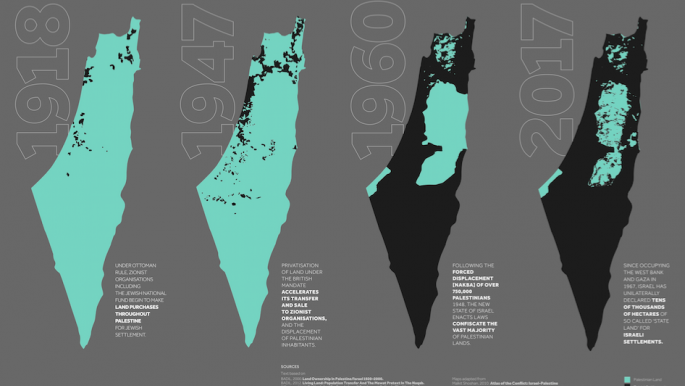
The Gazans who will live and die without ever seeing Palestine
Earlier this month, Israel admitted that it's actively working to block Palestinians from the Gaza Strip from settling in the Palestinian enclaves in the West Bank.
Under the Oslo peace accords that Israel signed with the Palestinian Liberation Organization in 1993, the West Bank and Gaza are supposed to be treated as a single territorial unit. But Gazans are almost never allowed to cross to the West Bank, or vice versa.
Rare exceptions do exist, in what Israel deems "humanitarian cases;" such as Gazan cancer patients seeking locally unavailable medical treatment in West Bank hospitals.
Some of the few Gazan patients allowed to the West Bank end up using this once-in-a-lifetime opportunity to be reunited with their families in the other half of the occupied Palestinian territories (oPt), and eventually choose to stay.
By doing so, they immediately compromise their ability to travel abroad or even between different Palestinian cities in the West Bank, and must avoid getting caught by Israeli policemen or soldiers at any of the numerous checkpoints punctuating the oPt, or risk being sent back to Gaza.
If this isn't hard enough, the Israeli government has officially stated that it views the 2,671 Gazans living in the West Bank as "illegal aliens," and shamelessly admitted that it's exerting significant efforts to "halt the growth" of their numbers and "prevent their settling" in Palestinian Authority-controlled West Bank areas.
One drastic measure with grave and potentially fatal consequences was to add another baseless, brutal and criminal criterion of "concern of illegally remaining in the West Bank" as sufficient grounds to reject Gazan travel petitions for medical treatment in the oPt. Another measure is to condition petition approval upon the return of a petitioner's relatives from the West Bank, even if the petitioner is in urgent need for immediate medical intervention.
 |
Sealing off Gaza renders its caged population faceless, dehumanised and confines them to mere statistics which inspire little or no empathy |  |
This preposterous policy essentially encapsulates some of the core injustices of Israel's apartheid system.
To unpack this divide and rule paradigm on a more personal level, think about how, since my birth, Israel decided in its population registry that I belong to the Gaza enclave. As a result, I am, by default, never allowed to move to, or even visit (unless I have cancer) the other Palestinian territories in the West Bank and East Jerusalem, let alone see or visit Israel itself.
Of course, I remain far luckier than my maternal and paternal aunts and uncles, whom Israel refused to include in the population registry after Oslo. Consequently, they and their descendants are never allowed to move to or visit Gaza and the West Bank. Instead they remain refugees confined to living as part of the diaspora, like about 6 million other Palestinians.
There are of course far-reaching destructive consequences of this apparatus on the overall Israeli-Palestinian conflict, when most besieged Gazans live and die without ever seeing the other side of the fence.
 |
|
One reality of such brutal separation is that the only thing blockaded Gazans get to glimpse of the mostly inaccessible West Bank, is endless footage of home demolitions, land theft, arbitrary arrests and state-sanctioned IDF and settler raids against Palestinians.
This makes Gazans paranoid and fearful of a fate similar to what amounts to ethnic cleansing in the West Bank.
Another consequence is that the only thing beleaguered Gazans see of Israel - and in great abundance - is tanks, warplanes, gunboats, snipers, drones, artillery, missiles and angry speeches of Israeli politicians justifying our slow death and pledging even harsher torment.
Israel likes to complain that Gazans "hate us," but it's worth asking what feelings - other than hate, anger and fear the entrapment in such apparatus of isolation and collective punishment - their actions would ever generate.
 |
It's time to give Gazans the normal life that we so plainly deserve |  |
Equally unfortunately, the only thing Israelis - and the international community - get to see of a sealed off Gaza is not its anguished people and their legitimate struggle for freedom and dignity, but rather an occasional launching of primitive projectiles towards southern Israel; sometimes to shake up the status quo, other times as an SOS for the world to come to Gaza's recuse, or a call for Israel to fulfill ceasefire promises, such as allowing Qatari aid into the enclave.
As Israel knows full well, the most destructive part of Israel's blockade on Gaza is preventing people on both sides of the fence from seeing and understanding each other's grievances, and banning international observers - and Israelis - of seeing what's become of Gaza.
Sealing off Gaza renders its caged population faceless, dehumanised and confines them to mere statistics. Statistics inspire little or no empathy; which makes it easier to visit the severest miseries upon the children of an impersonal population without fear of many consequences.
In turn, the isolation and torment of Gaza breeds only dangerous despair causing further violence and hate.
Ending this cycle of misery begins with tearing down the walls of isolation and despair of Israel's siege on Gaza. Let Gazans see the West Bank and Israel, and vice versa. It's time to give Gazans the normal life that we so plainly deserve.
Muhammad Shehada is a writer and civil society activist from the Gaza Strip and a student of Development Studies at Lund University, Sweden. He was the PR officer for the Gaza office of the Euro-Med Monitor for Human Rights.
Follow him on Twitter: @muhammadshehad2
Opinions expressed in this article remain those of the author and do not necessarily represent those of The New Arab.





 Follow the Middle East's top stories in English at The New Arab on Google News
Follow the Middle East's top stories in English at The New Arab on Google News


